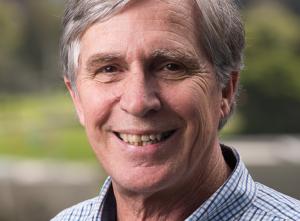A response to the May 2017 From the Editor by PUF Editor-in-Chief Steve Mitnick
Ed Smeloff leads Vote Solar's regulatory team. Vote Solar is involved in regulatory activities in twelve states. He is the author of "Reinventing Electric Utilities: Competition, Citizen Action and Clean Power."
In the May 2017 From the Editor column and other online columns, Steve Mitnick outlined the constraints facing those who would rely on wind and solar generation for most of their electricity supply. He also outlined the problems with electricity storage. Ed Smeloff takes issue with Mitnick's presentation of those problems.

Ed Smeloff takes issue with Mitnick's presentation of those problems.
Back in the 1970's, concepts like flexible demand and distributed generation wouldn't have meant much to electric utility managers or their regulators. Energy storage in the form of batteries powered flashlights and transistor radios, not cars or computers. Today, these cool concepts have materialized into hard technologies that are disrupting the way electricity is provided and consumed.
Constraints that were once thought to be immutable are giving way to information and communications technologies that are empowering consumers, improving the operation of power systems and expanding awareness of network use.
Widespread understanding of the consequences of climate change, right now and for future generations, has motivated many younger and not-so-young Americans to push for a low carbon future. This convergence of idealistic aspiration and technological advancement should be seen as an opportunity for those in the electricity business.
The accelerating growth in the use of wind and solar power generation across the U.S. has been nothing short of amazing. In 2016, more than half of the twenty-four thousand megawatts added in the U.S. came from renewable sources. There are now more than one million residential solar installations nationwide.
States like Iowa, Kansas and Oklahoma are big exporters of wind energy and could export more, with added transmission. California's investment in solar is driving regionalization of the transmission system operation across the west. Companies like Microsoft, Apple, General Motors and Walmart are setting off on their own to procure renewable resources in a more open market.
Many utilities are adapting to a future with many more variable output resources connected to the grid. Rural electric cooperatives are now paying customers for the right to use their hot water heaters as energy storage systems. San Diego Gas and Electric and Southern California Edison are piloting large-scale electricity storage as an alternative to leaky underground gas storage.
Companies as diverse as Google and WeatherBug are going beyond smart thermostats to provide automated real-time control of energy demand. Some electric utilities are again recommending all-electric homes as safer, healthier, more environmentally friendly and better for the grid.
There is one cold hard fact that has surprised some utilities and regulators. Businesses are figuring out how to produce more goods and services with less electricity use. And consumers are using less electricity with increased comfort and security.
Electricity productivity, according to the Energy Information Administration, has increased by fifty-eight percent from 1990 to 2015, which is more improvement than in any other advanced economy in the world during that period. We are getting more from less.
This declining rate of growth in electricity use has raised concerns about the profitability of parts of the electric industry. That challenge has prompted short-term responses like the introduction of demand charges for residential customers that reduce utility risk, but introduce barriers to longer-term innovation. It has also spawned interest in out-of-market solutions to preserving nuclear power, such as the award of zero-emission credits in New York and Illinois.
On the other hand, utility regulators in many states are recognizing the increasingly important role of distributed energy resources.
They are beginning to set in place a framework of market prices and regulated charges to create a balanced portfolio of cost-effective resources, both centralized and distributed.
Vote Solar expects the interplay between the aspiration for a low carbon future, market and technological innovation and fair regulatory treatment of past utility investments will unfold state-by-state.
A more active and informed citizenry, involved in plotting electricity's path forward, isn't a cold, hard truth. It's a good thing.
Your strong opinions are most welcome. Send them to mitnick@fortnightly.com. We'll publish the best. Letters typically range from 200 - 500 words.



